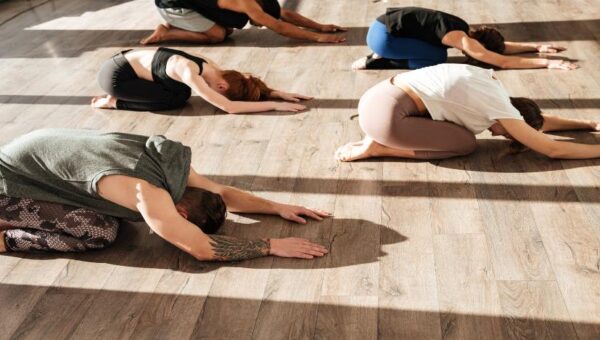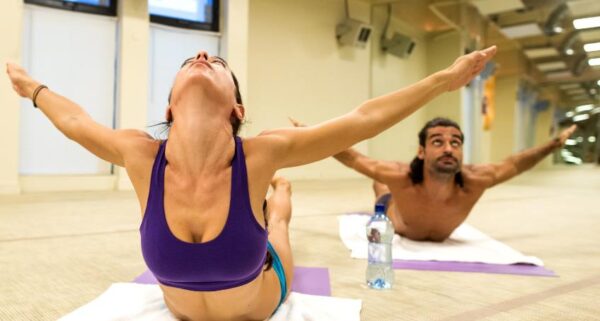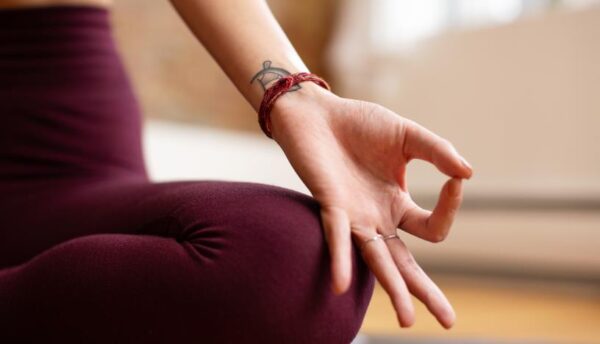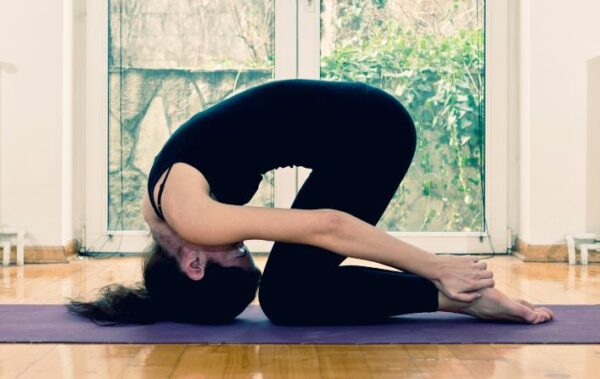Hot yoga has gained popularity in recent years, with practitioners flocking to studios with elevated temperatures. But just how hot is hot yoga? Are the benefits of practicing yoga in a heated room worth the sweat? Let’s dive into the science behind the heat and uncover the truth about hot yoga temperature.
Key Takeaways
- A typical hot yoga class is set between 90 and 105 degrees Fahrenheit (32 and 40 degrees Celsius).
- The heat promotes the release of toxins, increased flexibility, improved circulation, and reduced stress levels.
- The intensity of hot yoga can vary depending on the style and individual fitness level.
- Sweating in hot yoga aids in detoxification, muscle relaxation, and fluid balance.
- Beginners should approach hot yoga with caution, gradually increasing their intensity level and staying hydrated.
Benefits of Practicing Hot Yoga

Hot yoga offers numerous benefits for both your mind and body. The practice of hot yoga involves performing traditional yoga poses in a heated room, typically set between 90 and 105 degrees Fahrenheit (32 and 40 degrees Celsius). The combination of heat and yoga poses provides a unique experience that can have a positive impact on your overall well-being.
Improved Flexibility and Blood Flow
One of the key benefits of hot yoga is the ability to enhance your flexibility. The heat in the room helps to warm up your muscles, allowing for deeper stretches and a greater range of motion. With regular practice, you’ll notice a significant improvement in your flexibility, which can be beneficial for preventing injuries and increasing your overall agility.
The increased heat also promotes better blood flow to your muscles. This improved circulation can help to deliver oxygen and nutrients to your muscles more efficiently, allowing them to perform better and recover more quickly.
Mindfulness and Mental Well-being
Hot yoga is not just a physical practice, but also a mental one. The heat and intensity of the class require you to stay present and focused on your breath and movement. This increased mindfulness can have a positive impact on your mental well-being, helping to reduce stress, anxiety, and negative mood states.
The combination of deep breathing and challenging poses in a hot yoga class can also stimulate the release of endorphins, the body’s natural feel-good chemicals. This can leave you feeling uplifted, refreshed, and more positive after each practice.
Detoxification and Weight Loss
Hot yoga can aid in the detoxification process through sweating. The elevated temperature of the room promotes sweating, which helps to eliminate toxins from your body. Although the idea that sweating eliminates toxins completely lacks scientific evidence, sweating does contribute to the elimination of some chemicals, such as salt, potassium, ammonia, and urea.

The combination of heat, physical exertion, and increased heart rate in hot yoga also leads to a higher calorie burn compared to regular yoga. This can contribute to weight loss and help you achieve your fitness goals when combined with a balanced diet and other forms of exercise.
| Benefits of Practicing Hot Yoga | Hot Yoga Benefits and Risks | Hot Yoga Health Benefits |
|---|---|---|
| Improved flexibility | Reduced stress and anxiety | Detoxification |
| Increased blood flow | Enhanced mental well-being | Weight loss |
| Mindfulness and focus |
How Hot is Hot Yoga?
Hot yoga is known for its intense physical practice, challenging both your strength and flexibility. The key factor that sets hot yoga apart is the elevated temperature and humidity levels in the room. Typical hot yoga studio temperatures range from 90 to 105 degrees Fahrenheit (32 to 40 degrees Celsius).
“The heat in a hot yoga class can make the practice feel more intense, requiring focus and determination to maintain proper form and alignment throughout the session.”
The hot yoga room temperature creates an environment that intensifies your workout, pushing your body to new limits. As the room heats up, your muscles become more pliable, allowing for deeper stretching and improved flexibility. The increased temperature also stimulates blood flow, enhancing circulation and promoting a healthier cardiovascular system.
It’s important to note that the intensity level of hot yoga can vary depending on the specific style being practiced and your personal fitness level. Some hot yoga classes may focus on dynamic movements and fast-paced sequences, while others may emphasize long holds and deep stretches. Remember, choosing the best yoga dress for your hot yoga class is essential.
Hot Yoga Intensity Levels
In hot yoga, the intensity level is determined by a combination of factors, including the room temperature, the poses performed, and your individual effort. Here are some common intensity levels you may encounter in hot yoga:
| Intensity Level | Description |
|---|---|
| Low Intensity | A slower-paced practice with gentle movements and extended holds. |
| Medium Intensity | A balanced practice incorporating a mix of strength, flexibility, and balance exercises. |
| High Intensity | A vigorous and challenging practice with fast-paced sequences and advanced poses. |
Remember, Preparing is important and listening to your body and respecting your limitations is crucial in hot yoga. It’s important to stay hydrated, take breaks when needed, and never push yourself beyond your comfort zone.
Now that you understand the hot yoga room temperature and intensity, you’re ready to embrace the challenge and experience the unique benefits it offers.
Sweating in Hot Yoga

In a hot yoga class, the combination of elevated room temperature and humidity creates the perfect environment for sweating. Sweating is a natural response to the heat, and it serves several important purposes in hot yoga practice.
Sweating helps to regulate the body’s temperature by cooling it down. The heat of the room stimulates the sweat glands, causing them to produce sweat that evaporates from the skin’s surface, creating a cooling effect. This process helps to prevent overheating and allows you to continue practicing in the hot environment comfortably.
But sweating in hot yoga goes beyond just temperature regulation. It also plays a crucial role in detoxification and improving flexibility.
“Sweating is the body’s way of getting rid of toxins, waste products, and chemicals,” says Dr. Lisa Levine, a renowned yoga expert and medical doctor. “When you sweat, your body eliminates various substances through sweat glands, including salt, potassium, urea, and even small amounts of ammonia.”
The act of sweating helps to cleanse the body by flushing out impurities and promoting the elimination of certain chemicals. While sweating alone does not eliminate all toxins from the body, it does contribute to the detoxification process.
Additionally, sweating in hot yoga is beneficial for loosening the muscles and enhancing flexibility. The heat and humidity of the room help to relax the muscles, making them more pliable and easier to stretch. As you sweat, your muscles become warmed and lubricated, allowing for deeper and more effective stretching throughout your practice.
It’s important to note that as you sweat, your body loses fluids and electrolytes. To stay properly hydrated and replenish what you’ve lost, it is crucial to drink plenty of water before, during, and after your hot yoga practice.
Hot Yoga for Beginners
Hot yoga may seem intimidating for beginners due to the heat and intensity of the practice. However, with the right approach, it can be a rewarding and transformative experience. If you’re new to hot yoga, it’s important to listen to your body and prioritize your safety and comfort throughout the practice.
“Hot yoga can be challenging for beginners, as the heat and intensity of the practice may be overwhelming.”

To help you navigate your hot yoga journey, here are some essential tips for beginners:
1. Listen to Your Body
Pay attention to how your body feels during the practice. If you start to feel lightheaded, dizzy, or extremely fatigued, take a break and rest. It’s okay to sit down or lie in Savasana (corpse pose) whenever you need to regain your energy.
Remember, everyone’s tolerance to heat varies, so don’t compare yourself to others in the class. Recognize your limits and honor your body’s signals.
2. Stay Hydrated
Drink plenty of water before, during, and after your hot yoga class. Hydration is crucial to prevent dehydration and maintain optimal performance. Bring a water bottle with you and take sips whenever you feel the need.
Hydrating with electrolyte-rich beverages like coconut water can also help replenish lost minerals due to sweating.
3. Start with Regular Yoga Classes
If you’re new to yoga, it may be beneficial to start with regular yoga classes before transitioning to hot yoga. Regular yoga classes can help you build strength, improve flexibility, and become familiar with the foundational poses.
“It may be beneficial for beginners to start with regular yoga classes before transitioning to hot yoga to build strength and familiarity with the foundational yoga poses.”
4. Focus on Proper Alignment and Breath
In hot yoga, it’s essential to maintain proper alignment and focus on your breath to avoid injury and make the most of your practice. Take your time to understand the correct alignment of each pose and allow your breath to guide you through the movements.
“Hot yoga differs from regular yoga in the added element of heat and intensity, making it important for beginners to approach the practice with caution and gradually increase their intensity level.”
5. Gradually Increase Intensity
As a beginner, it’s important to gradually increase the intensity of your hot yoga practice. Don’t push yourself too hard or try to match the intensity of more experienced practitioners. Instead, focus on building strength, improving flexibility, and becoming familiar with the heat.
Over time, your body will adapt to the heat, and you can gradually challenge yourself with more advanced poses and longer practice durations.
“Hot yoga can be an intense and transformative practice. It’s essential for beginners to approach it with caution, listen to their bodies, and gradually increase their intensity level.”
